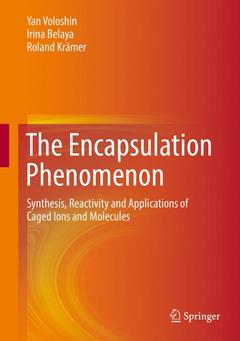Description
The Encapsulation Phenomenon, Softcover reprint of the original 1st ed. 2016
Synthesis, Reactivity and Applications of Caged Ions and Molecules
Authors: Voloshin Yan, Belaya Irina, Krämer Roland
Language: English
Subjects for The Encapsulation Phenomenon:
Keywords
Molecular flasks; Caging ligands; Cation encapsulation; Anion encapsulation; Encapsulation of neutral molecules; Macrocyclic compounds; Cage compounds; Supramolecular capsules; Photochemistry of encapsulated species; Chemical separation; Caging sensors and caged probes; Host-guest interaction; Molecular and supramolecular devices; Molecular carriers
Approximative price 210.99 €
In Print (Delivery period: 15 days).
Add to cartPublication date: 05-2016
Support: Print on demand
Approximative price 210.99 €
In Print (Delivery period: 15 days).
Add to cartPublication date: 05-2018
Support: Print on demand
Description
/li>Contents
/li>Biography
/li>Comment
/li>
An exhaustive summary of cage compounds and their chemistry, summarizing synthesis and introducing reactivity and applications
Contains over 850 literature references, clearly represented in over 600 schemes and illustrations
Clearly structured: separated chapters for each type of caging ligands (covalent, supramolecular, and coordination capsules), ordered by ligand classes and types of encapsulated species (cations, anions and neutral molecules)




